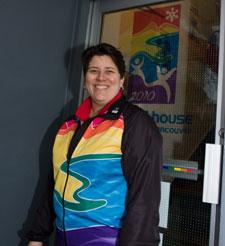Vancouver’s Olym-pics may go down in history as the gayest ever. Although most gay and lesbian athletes are still reluctant to come out as they compete for Olympic gold, three groundbreaking gay spaces have shone a spotlight on the community and given its members places to gather at the 2010 Games.
“I think we’ve broken open the closet door of sport,” says Jennifer Breakspear, director of Vancouver’s Pride House, in the heart of the gay village.
Like the many provincial and country pavilions dotting the Olympic landscape here, this pavilion is for the gay nation.
“Never has there been something of this scope. Never has there been a recognized entity that is a welcome space, that is a safe space for the LGBTQ community. A place where all queer people from around the world can find community,” she says.
Breakspear says the Bute St Pride House has had many visitors and huge international media attention since it opened its doors Feb 11.
“The dialogue is happening,” she says, referring in part to exchanges overheard among Pride House visitors discussing homophobia in sport.
Breakspear has also had requests for information regarding refugee status from visitors during the Games, though no formal claims for asylum have been made.
The Whistler Pride House has also been a success since it opened its doors Feb 8, say coordinators Ken Coolen and Dean Nelson.
“We’ve had quite a few different people go through,” says Nelson. Coolen estimates at least 500 guests, including international and local media, had visited Whistler Pride House by the Games’ midpoint.
Nestled in the rock façade of Whistler Blackcomb’s Pan Pacific Hotel, Pride House’s easily identifiable rainbow banner welcomes gay athletes, tourists, locals and allies. Inside, an art exhibit reflects the strength and fearlessness of openly gay athletes, a statue celebrates the male form as a nude hockey player winds up for a slapshot, a colour-coded map of the world marks the most accepting and most homophobic countries, and a “shotski” — a single ski with shot glasses glued to it — sits on the bar, waiting for the party to get started.
“If there are athletes who are gay and lesbian and transgender — and there are, we know there are — hopefully Pride House will give them the opportunity to come and be themselves,” says Karen McCormick, an out lesbian and volunteer at Whistler’s Pride House.
At the Vancouver Pride House launch, gay city councillor Tim Stevenson publicly challenged London and Russia, which are hosting the 2012 and 2014 Games respectively, to have Pride Houses at their Olympics too.
The Pride Houses weren’t the only gay spaces at the 2010 Games. The province of BC hosted its own cocktail party for members of the gay community and international media and tourism professionals at the BC Canada Pavilion Feb 19.
Held on the fourth floor of the Vancouver Art Gallery, the party was the brainchild of Philip Steenkamp, president and CEO of the Olympic and Paralympic Games Secretariat, the provincial agency responsible for overseeing the Winter Games’ financial commitments.
“It seems obvious to me [that Vancouver] has the whole world here and there should be an opportunity to welcome the international LGBTQ community,” Steenkamp told Xtra West before the party.
“It’s really to bring the community together,” he said, adding that the soiree was also a way to network globally and bring future gay tourism dollars to the city.
As Steenkamp welcomed the partygoers Friday night, he thanked his partner for all his support. “He is a true Olympic widow,” he quipped.
Steenkamp then announced that the Olympic rings at Coal Harbour would glow hot pink in honour of the evening’s gathering.
“I think you do have to create space for the LGBT community. You have to create physical space, but it’s also cultural space as well. It sets an example,” he says.
“That’s part of the beauty of the Olympic movement is you have the ability to spread these universal values. I’m not naïve to assume that it would be easy to do this in any place because it isn’t, and we all know that,” he continues. “But where it is easy, I think we almost have an obligation to do so.”
For Coolen, the success of gay spaces like Pride House lies in their ability to move progress forward. Homophobia “is a huge, huge mountain that needs to be moved, and we’re never going to move a mountain but we can take chips off it a little bit at a time,” he says. “Eventually the mountain is going to get smaller, and that’s what we’re heading towards.”
As for openly gay and lesbian athletes at these Olympics, there are still very few. But Dutch speed skater Ireen Wüst, who reportedly came out to TVM Helden last fall, won gold in the 1,500-metre speed skate Feb 21.
Attempts by Xtra West to contact Wüst were unsuccessful by press time.

 Why you can trust Xtra
Why you can trust Xtra


